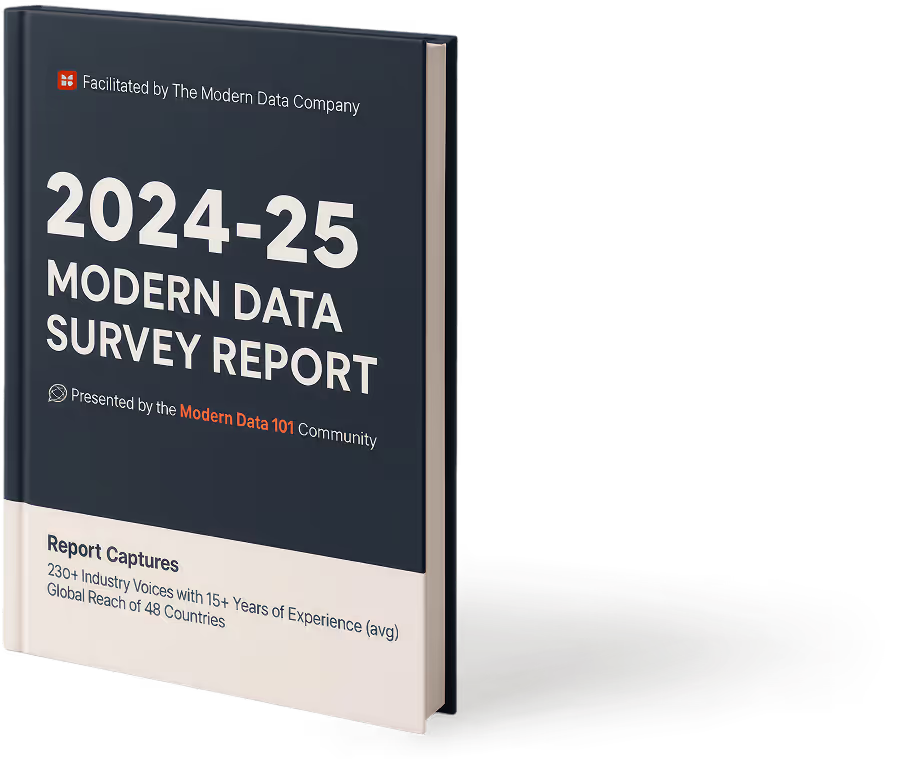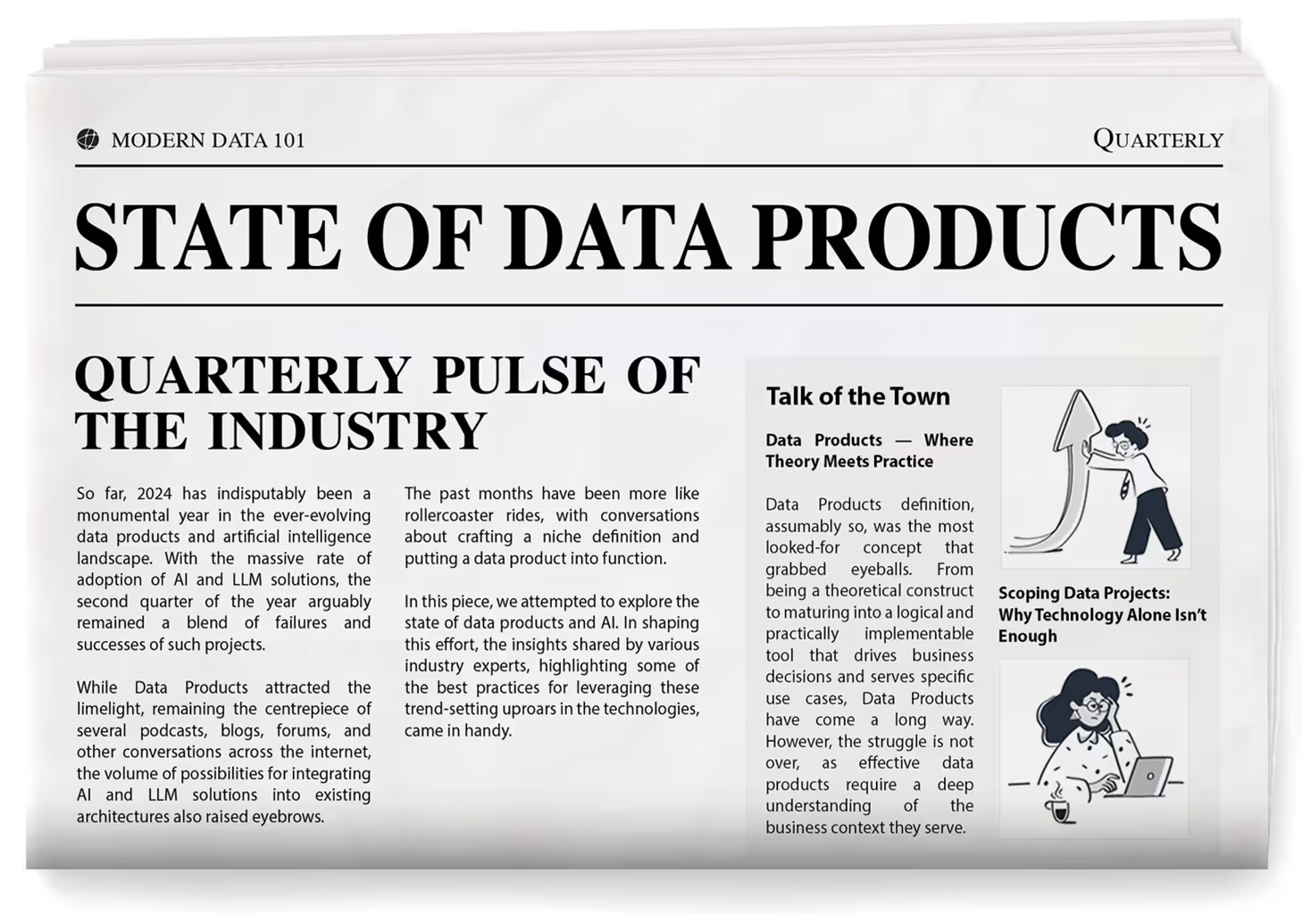
TL;DR
Modern enterprises are quickly moving from disjointed, siloed project-based initiatives to a more product-oriented, sustainable approach. With 402.74 million TB of data generated each day, things are cut out for teams out there.
Investments have become intensive, owing to the need to derive maximum value from an organisation’s data. Analytics stacks, tools for orchestration, and securing the right team members require considerable resources. Things fall apart when enterprises fall behind in quantifying the value of these investments. Adding to the woes are situations where stakeholders ask questions like: Is our data use affecting the way we make decisions? Are costs being optimised? What are the business goals we intend to drive, when a huge 56.4% product managers are struggling with completing organisational objectives?
While finance is obviously a topic of any investment conversation, ROI has become a North Star goal for businesses, a starter in most strategic discussions. ROI drives the priority of various initiatives, creates accountability across business and technical teams, as well as ensures proper utilisation of resources among many other functions. ROI measurement, when done effectively, not only evaluates previous performance but also takes the future into account.
Data problems are one thing that enterprises are solving with a more productised vision for data, with data products in place, but on the other end of the horizon is evaluating how fruitful data products are turning out to be for these enterprises. While there is no doubt that things are evolving, there is still a critical factor to consider and get right: measuring the ROI of data products, which is the foundation of a successful data strategy, one that is steeped in performance, transparency, and effective business outcomes.
Understanding ROI in the Context of Data Products
Return on Investment is often taken into account with a narrow approach, where costs are compared to immediate gains in terms of revenue. However, in the context of data products, it is too confined an approach. A great ROI measurement framework should account for both tangible and intangible value that is closely aligned with the ways modern enterprises use data for competing, operating, and complying.
Data products are never responsible for creating direct revenue. What they do is enable operational efficiency, reduce risks, and increase the trust quotient of gathered insights, contributing to business value in the long run. For example, a data product to sort out regulatory reporting might not boost overall growth, but could lead to significant cost savings in avoiding compliance overheads and audit fines.
This highlights that data products are not simple, one-time deliverables, but assets that should be invested in for the long haul. The value adds up over time, with cross-team adoption, reuse, and consistent evolution over time. In such situations, measuring ROI not just helps take note of the immediate impact, but also how it continues serving its domain across different business cycles.
Because of its nature, ROI needs to be intertwined within organisational goals. If an enterprise is really looking to achieve growth, then KPIs such as the effectiveness of customer segmentation campaigns and overall lift will matter a lot.
Understanding ROI for data products entails the need to move from dashboards and monetary gains to a more value-driven and strategic assessment.

Components that Influence the ROI of Data Products
To evaluate the ROI of data products meaningfully, organisations need to move from the biased view of only cost benefits and assess multiple dimensions to uncover actual data efficiency.
A few critical components that constantly influence the value of ROI for data products can be categorised as:
1. Adoption and reuse
The foundational driver of ROI for any data product is its adoption. A well-crafted product that goes unused yields no return, regardless of the effort or investment behind it. True ROI emerges when the data product becomes part of daily workflows—used regularly, by multiple stakeholders, across different teams or domains. Reusability enhances this effect further. When a single product serves multiple use cases without requiring duplication or rework, it creates a compounding return. Think of a customer profile data product reused across marketing campaigns, customer support analytics, and personalisation engines. That’s when the value really starts to scale.
2. Time to value
Speed matters. The quicker a data product enables users to derive insights or take action, the higher its return. Many data initiatives fail not because the data was wrong, but because it arrived too late to be useful. A data product that reduces the time users spend finding, cleaning, or decoding information significantly improves productivity. This speed not only improves decision-making but also builds trust and habit around the product, reinforcing its value in the ecosystem.
3. Self-serve capability
Empowering users to explore and extract value from data products without dependency on central data teams is a major ROI lever. Self-serve capabilities reduce turnaround time, lower operational burden, and unlock insights at scale. When users can access data directly through ready-to-use interfaces and clear metadata, it reduces handoffs and accelerates outcomes. This shifts data teams from service providers to product enablers, while making data access faster, broader, and more scalable.
4. Alignment to Business Use Cases
ROI improves when a data product is directly tied to a business outcome. Products built without that alignment often see low adoption or unclear value. But when a product supports a specific goal, like speeding up forecasts or improving customer actions, the impact is easier to measure. This clarity also helps teams decide what to invest in, what to scale, and what to retire.
5. Revenue
Data products influence the overall enterprise revenue to a large degree, even if the latter remains a little tricky to measure. Better personalisation, improved targeting, and quicker iteration of campaigns, powered by superlative data products, can be a crucial element in boosting top-line growth.
6. Costs
Costs cut across infrastructure (storage, cloud capacity), people (operations, engineering, analytics), and tooling (APIs, licenses). Determining the total cost of ownership across the complete product lifecycle stages, such as maintenance, support, and development, is essential to measure the return on Investment more effectively.
7. Risk Mitigation
Data products also play a crucial role in risk mitigation, with enhanced compliance, early anomaly detection, and reduced exposure to sensitive data. While the outcomes of such practices never make it to the revenue sheets, they play a key role in maintaining a regulatory standing and reputation of the enterprise.
8. Metrics for Data Usability
Factors, such as documentation quality, lineage clarity, and discoverability, boost the levels of data usability in ways that make it critical for success. Easy-to-find, understandable, and trustworthy data products will always find higher adoption levels, boosting their overall returns while also reducing duplication in the process.
All these components offer a detailed insight into the evaluation of both short-term and long-term value of data products.
How Important are KPIs in ROI Measurement
Key Performance Indicators, or KPIs, have a foundational role in measuring the ROI of data products. Without properly defined KPIs, ROI remains something present only on paper. Data product KPIs deliver a measurable link between data activities and outcomes, converting the value assessment process from hypothesis to evidence.
As far as ROI measurement is concerned, data product KPIs play two crucial roles. We mention them below:
- They help in defining ROI with real usage and performance metrics, giving enterprises proper insight into whether the product is functioning well, and also whether this functioning is aligned with the intended objective.
- KPIs also help in taking the data measurement conversation beyond just operational efficiency, offering increased visibility into the impact on decision-making, user experience, and speed.
Given below are a few instances of outcome-driven KPIs with the potential to truly make a difference:
- Usage Frequency: It measures how frequently a data product is queried by end users across teams. High usage frequency indicates consistent value delivery, while low usage might be a sign of misalignment in business objectives or other issues.
- SLA Adherence and Uptime: This KPI tracks the availability and trustworthiness of data in accordance with the defined Service Level Agreements (SLAs). Also, ensuring consistent uptime establishes trust among different users while also helping determine if the product can be depended upon for time-critical tasks.
- Improvement on Time-to-Insight: It captures the reduction in time taken to transition from raw data to actionable insights. Reduced time-to-insight boosts the pace of decision-making, cuts down silos, and boosts the overall responsiveness in dynamic business ecosystems.
- Decision to Implementation Speeds: The KPI is responsible for discovering how the insights derived from a data product are applied to business actions in real-time. It shows how tightly a product is within the operational workflows and how it helps in driving execution.
- Reduced Manual Reporting: This one quantifies the saved time with the automation of activities that were previously manual and repetitive. It opens up analyst and engineering capabilities, reduces the chances of human risk, and links directly to efficiency-governed ROI.
ROI Measurement Models and Frameworks
When it comes to measuring the ROI of data products, the models need to move beyond the usual cost and revenue paradigm. Enterprises need a properly designed framework for the entire data product lifecycle and its impact.
Below, we discuss three effective models to help convert data investment into business value that can be measured seamlessly:
- Input-Output Efficiency Matrix
This model evaluates inputs on efforts and cost, such as compute resources, engineering hours, as well as platform spend, against outputs such as adoption, usage, time savings, and delivered impact.
The matrix assists enterprises in quickly identifying high-effort, low-impact products that may need a redesign or the low-effort, high-impact ones that need the right kind of scaling. This matrix prioritises the ratio between efficiency and value.
- Data Product Value Stream Mapping
This lean method tracks every single step of a data product, from the initial ideation to user adoption, and in the process, highlights delays, inefficiencies, and handoffs. It is also helpful in minimising the not-so-obvious bottlenecks impacting the time to value realisation and user trust.
Once these flows are mapped effectively, they lead to the uncovering of hidden costs and value, making it easier to ensure delivery optimisation and impact scaling.
- Total Cost of Ownership (TCO) + Value Realisation
TCO factors in all the cost components involved, such as development, deployment, maintenance, and governance. When these are combined with different value-based metrics like process automation, risk reduction, time to insight, and the like, teams can calculate more accurate ROI with this framework.
The formula for this is: ROI = (Business Value-TCO)/ TCO
The ROI frameworks and models offer enterprises scalable means to measure, refine, and maximise the ROI of enterprise data products, ensuring that each data effort is efficient, accountable, and outcome-based.
Challenges in Measuring Data Product ROI
While it may seem easy, measuring the ROI of data products can become a really complex process over time. Reports and dashboards indeed offer a few insights, but they also often lead to inaccurate value interpretations.
To avoid such situations, here are a few critical data product ROI pitfalls that you should definitely try to avoid:
1. Overdependency on Usage Metrics and BI Reports
A common assumption among teams is that keeping tabs on the dashboard or query views leads to genuine value. While these metrics do shed light on the volume of activity, there is no information on whether data products played a role in better workflows, influenced decision-making, or led to the achievement of business objectives in some way.
2. Ignoring the Differences Between Short-term and Long-term ROI
While some data products offer immediate impact and value, others tend to be strategic investments that evolve. Failure in identifying differences between short-term and long-term value realisation can lead to premature judgements.
3. Focusing More on Activities Than Outcomes
Tracking the number of pipelines and delivery milestones might be representative of productivity, but it is never reflective of outcome-oriented performance. ROI should emphasise more on measurable improvements in efficiency, cost savings, and decision speeds, and not just be a data asset.
4. Employing Static Models in a Dynamic Ecosystem
With the evolution of data products, the frameworks used to measure their impact also need to evolve. A rigid ROI model which doesn’t adapt to changing user requirements, product maturity definitions, and dynamic business objectives will miss the full value impact.
Steering clear of these pitfalls enables enterprises to make sure that their ROI assessment is thoughtful, relevant, and entirely aligned with strategic objectives.
Building a System for Continuous ROI Tracking
Measuring the ROI of data products should not be an exhausting and inefficient activity; rather, it should be a capability that’s embedded deep into the product lifecycle. As data products evolve, the metrics should too. ROI tracking automation allows teams to take corrective measures well in advance, stay aligned with business objectives, and optimise impact effectively.
This is where a Data Developer Platform (DDP) plays a vital role. With the automation of observability and data governance, DDP eliminates the need for collecting KPIs and spreadsheets manually. The platform-oriented dashboards offer real-time visibility into metrics such as usage, lineage, uptime, as well as SLA adherence.
Enterprises should also be mindful of the fact that even automation won't be enough. For a system to ensure continuous ROI measurement, there’s a need for cross-functional collaboration, too. Where product managers ensure alignment with business objectives, engineering teams develop the right observability points, and domain teams assess the value impact. Such shared ownership helps in creating a culture of value realisation and accountability.
Takeaway: ROI is Just a Checkpoint, but Not an Enabler
In the context of data products, ROI should not be considered as the final threshold or metric. Instead, it needs to work as an organisational enabler, and a driver of better design philosophies, deeper alignment with organisational goals, and a more pinpoint prioritisation of processes in workflows.
A mature ROI mindset moves beyond justifying costs to focus on ensuring maximum impact, so that each product sensibly contributes to outcomes such as compliance, efficiency, decision pace, or growth.
Strategic ROI measurement of data products is the cog that transforms data from an undefined cost into a robust, competitive asset that’s not just embedded in activity, but in measurable business value.
Frequently Asked Questions (FAQs)
1. Why is measuring the ROI of data products more complex than measuring the ROI of conventional IT projects?
- Data products are adept at delivering both tangible as well as intangible value. For example, risk reduction and decision speed. This does not happen in the case of traditional IT projects. The actual value of data products is realised over time, and across multiple domains at the same time.
2. Is it possible to measure data product ROI in the early stages?
- Yes, data product ROI can be measured in the early stages, but only if the expectations are set right. In the early stages, you can focus more on indicators such as saved time, initial user engagement, and the degree of reduction in manual processes. With increased adoption over time, a larger number of outcome-powered KPIs, such as cost savings and revenue, can be included for better tracking.
Join the Global Community of 10K+ Data Product Leaders, Practitioners, and Customers!
Connect with a global community of data experts to share and learn about data products, data platforms, and all things modern data! Subscribe to moderndata101.com for a host of other resources on Data Product management and more!
.avif)
A few highlights from ModernData101.com
📒 A Customisable Copy of the Data Product Playbook ↗️
🎬 Tune in to the Weekly Newsletter from Industry Experts ↗️
♼ Quarterly State of Data Products ↗️
🗞️ A Dedicated Feed for All Things Data ↗️
📖 End-to-End Modules with Actionable Insights ↗️
*Managed by the team at Modern



Author Connect 🖋️

Simran Singh Arora

Simran is a content marketing & SEO specialist.
Simran is a content marketing & SEO specialist.









